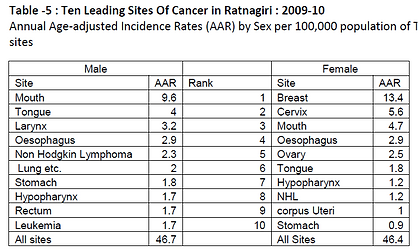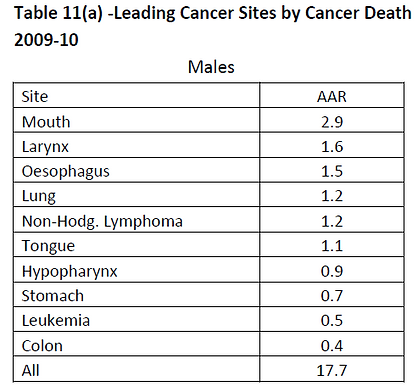
DERVAN RURAL CANCER REGISTRY
The Tata Memorial Centre (TMC), Mumbai, in collaboration with and BKL Walawalkar hospital (BKLWH), Dervan, has set up a Population based Cancer registry, located at BKLWH, Dervan. The Registry Programme was started in March, 2009.
In India, the only rural cancer registry is located at Barshi, Solapur district, Maharashtra; besides this there are several urban-based population registries in different parts of the country. Since there are no cancer statistics from Konkan region, it was felt necessary to set up a Cancer registry at Dervan in Ratnagiri district. The TMC is currently carrying out a large Out-reach programme in the Ratnagiri and Sindhudurg district since Aug 2003, which is screening high-risk groups. To evaluate the effectiveness of the screening programme, a cancer registry is essential. Cancer registry is the backbone for providing all information on the various patterns of cancer that are diagnosed from a geographical region.
What is Cancer Registry?
An office or the institution which collects, stores, analyses and interprets the data on persons with cancer who are treated in a particular institution or live in a particular geographic area.
Objectives of Cancer Registry
-
Generating reliable data on the magnitude and patterns of cancer – this would be based on Morbidity and Mortality information according to age, sex and residence of the patient, anatomical site of cancer etc.
-
-
To evaluate the Effectiveness of Ongoing Cancer Screening activities in the region.
-
-
Undertaking epidemiologic research, such as case control or cohort studies based on observations of registry data;
-
-
Providing database for developing appropriate strategies to aid in District Cancer Control Programme; this would be in the form of planning, monitoring and evaluation of activities under this programme.
Benefits and Outcomes
-
Enumeration of disease burden and patterns of cancer in the rural areas: The project will enable in identifying the disease burden and also the common cancers prevalent in the district of Ratnagiri.
-
-
National Gain: The valuable information collected will form a basis for planning a Cancer Control Programme in the country.
-
-
Research Potential: The project has an excellent potential for community based epidemiological study to identify the risk factors.
Scope at Dervan:
-
Cancer Registry at Dervan will enable us to obtain the true Incidence and Mortality rates in the Population.
-
-
The information that will be generated out of this Population will be of great value, both in terms of patient care and research.
-
-
Many epidemiological studies can be initiated in this Population since not much is known about the rural Population with regard to life-style, dietary habits etc other than the tobacco habits.
-
The registry staff is visiting several sources like hospitals, private practioners, pathology labs etc, in Ratnagiri & Sindhudurg district that has documents relating to diagnosis. This source of information is compiled in the registry database, by checking for duplicate registrations, residency status etc, before being populated into the Cancer Database. Till date, there has been an overwhelming response by all concerned, to our requests. This has been very encouraging, and the data so collected will be useful for a rural cancer database that will help in identifying the burden of cancer. This in turn will be useful for health authorities to initiate / updgrade the facilities for cancer diagnosis, treatment and research. This information will be useful for developing a District Cancer Control Programme as well.
-
METHODOLOGY:
-
-
Total 25 laks population (2001 census)
-
2268 Villages & 13 Town from 16 Tehsils of 2 Districts
-
Distribution – 1 Lakh population / Investigator
-
Coverage - Village with average 1000 population =1 Unit (1 day)
-
SOURCES OF INFORMATION:
-
Primary Source : Medical Record.
-
Secondary Source :Registers : Pathology
-
Radiology
Surgical Oncology
Radiation Oncology
Medical Oncology
-
DATA COLLECTED INCLUDES:
Patient identification and demographic information
Cancer identification
Diagnostic procedures
Cancer-directed treatment
Follow-up
FUNCTIONS OF CANCER REGISTRY:
-
-
Case finding
-
Registry Office
-
SCOPE:
-
-
Cancer Registry at Dervan will enable us to obtain the true Incidence and Mortality rates in the Population.
-
-
The information that will be generated out of this Population will be of great value, both in terms of patient care and research.
-
-
Many epidemiological studies can be initiated in this Population since not much is known about the rural Population with regard to life-style, dietary habits etc other than the tobacco habits.
-
METHODS OF DATA COLLECTION:
-
-
Identification of Sources of information (Done)
-
House survey
-
Linkages with TMCROP database
-
Linkages with the Municipal Corporation (Death records)
-
Group Meeting
-
Case abstraction
-
Follow up
-
Quality Control Checks
-
Analysis and Reporting
-











